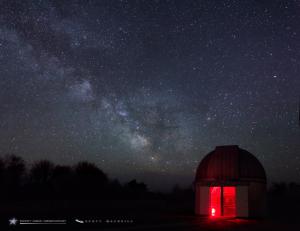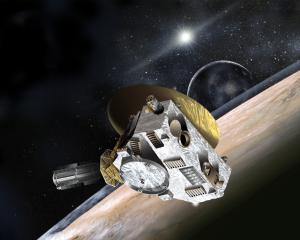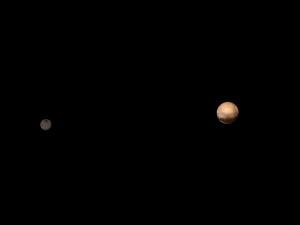
Public Stargazing
- Where:
- Frosty Drew Observatory
- When:
- Friday July 10, 2015 at 6:00 p.m.
- Cost:
- $1 Suggested Donation per Person
Tonight's forecast is calling for partly cloudy skies in the afternoon becoming clear overnight. Add in that the 21% waning gibbous Moon will not rise until near 2:00 a.m., and we could be in for a killer night. The forecast at this moment is still a bit conflicting, but largely we can expect clear skies after sunset with most anomalies happening in the late afternoon. With the late riser Moon, we will have essentially dark moonless nights this weekend, the kind of nights that keep us open until pre-dawn. Now all we need is weather to cut us a break and give us clear skies for fabulous Milky Way viewing, which is what looks to happen.
We plan to open the Observatory and Sky Theatre at 6:00 p.m. In the Observatory, live views of the Sun showcasing sunspot group 2381 as well as the emerging sunspot 2384 will be available. Once the Sun sets (8:15 p.m.), we will direct our telescopes towards Venus which has begun to wane quickly and is now in a 25% crescent phase. Jupiter will be on display briefly as it is quite low on the western horizon at sunset. Once we have had our fill of Venus' sexy crescent, we will direct the primary telescope towards Saturn showcasing the stunning rings and up-to 5 of Saturn's moons. Telescopes in the courtyard will feature star clusters, nebulae, and the many cosmic wonders that reside along the bright summer Milky Way. The Nature Center will be open from 7:00 p.m. - 10:00 p.m. with Naturalists on hand to answer questions and showcase what happens at the Frosty Drew Nature Center. The Sky Theatre will feature an astrophotography showcase of objects photographed at Frosty Drew Observatory.
Overall, tonight could be the best night of the summer yet! With a rather dim Moon, which will not rise until near 2:00 a.m., we are in for a night of super dark skies with the bright Milky Way visible all night once twilight wanes. Weather will progressively get better as the night continues and we may score if the skies clear early. Regardless, awesome times will be had tonight under the mesmerizing starscape. What a perfect night to meet that inner geek just waiting to jump out and revel in the cosmos. Do it at Frosty Drew tonight!
-------------------------------------------------------------------------
Weekly Happenings
Scott MacNeill
This coming Tuesday, July 14 at 7:50 a.m. EDT, the NASA New Horizons spacecraft will perform its anticipated epic fly-by of Pluto. Though all eyes will certainly be watching, New Horizons will be busy performing its primary mission within a tiny window of opportunity to spend any time dealing with crazed Earth-bound nail biters that are drooling for up close images of Pluto's ruddy surface.
Launching in early 2006, NASA New Horizons has been trekking the Solar System building up speed to reach the distant orbit of Pluto. Pluto currently resides at about 2.96 billion miles distant from Earth. At this point New Horizons has achieved massive speeds of 30,800 mph, way to fast to acquire orbit around Pluto. With New Horizons moving so fast, it will quickly pass by Pluto, which has a small diameter of only 1,471 miles. Starting tomorrow (Saturday), New Horizons will begin mapping Pluto and its largest moon, Charon, and will continue doing so until after the fly-by encounter completes.
Now we all want data and images, and we want them now! But at these extreme distances it will take 4.5 hours for communications to reach New Horizons and another 4.5 hours for communications to be received from New Horizons. The average broadband user is accustomed to around 20 – 100 Mbps (megabits per second) which enables Netflix streaming, VOIP, and a daily MMO dive into battle, thievery, or orc manipulation. But New Horizons, at near 3 billion miles away from Earth, has to transmit and receive all data over a 1 kbps (kilo-bit per second) connection. Geek-challenged? 1,000 kilo-bits = 1 megabit. With data transfer rates like that, we can expect a hefty delay in the amount of images and data returned from New Horizons collected during the fly-by. A delay of about 18 months! Now there will certainly be regular releases of new data over that time period, but a complete data set of the encounter will not be received until late 2016.
Though we may not see a super high res closeup of Pluto's surface on Tuesday morning, do not let that deter your viewing. I'm sure the New Horizons team will have previously unreleased images of Pluto, initial atmospheric readings, and enough information about New Horizons and Pluto to satisfy even the craziest Pluto advocating geeks. This is no doubt a historical moment, the point at which we pass Pluto at less than 8,000 miles distant and place a check mark next to another distant object on our Solar System exploration list.
Keep up with the mission at NASA New Horizons. Then tune into NASA TV on Tuesday morning at 7:30 a.m. to celebrate the Pluto Encounter at NASA TV. Woot!
-Scott


